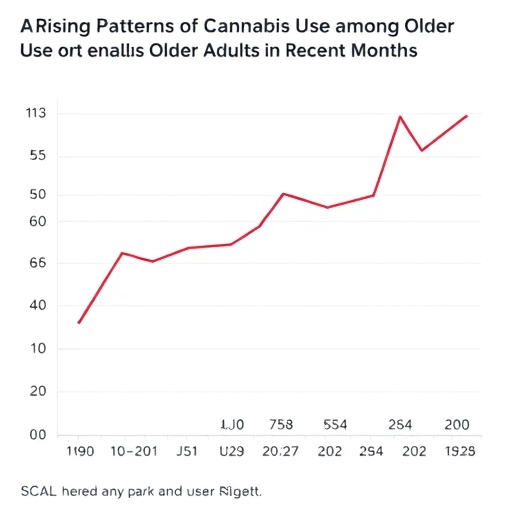Between 2021 and 2023, the United States witnessed a significant shift in cannabis consumption patterns among older adults, particularly those aged 65 and older. This demographic, traditionally not associated with high rates of cannabis use, has shown a marked increase in prevalence of current cannabis consumption nationwide. The findings of this recent study illuminate evolving trends in medical and recreational marijuana use within an age group often overlooked in cannabis research, signaling important implications for healthcare providers, policymakers, and the pharmaceutical industry.
The study’s comprehensive national analysis reveals that while cannabis usage rose across various segments of the older adult population, the most notable increases occurred among those with higher socioeconomic status. Initially, adults with the highest income brackets exhibited the lowest rates of cannabis use when compared with middle and lower-income groups. However, by 2023, this pattern reversed, with affluent older adults reporting the highest prevalence of use. This inversion points to evolving accessibility and affordability factors, potentially linked to medical cannabis markets which often impose substantial costs on users.
Understanding these socioeconomic dynamics is critical, especially in the context of medical cannabis. Unlike younger populations, older adults frequently encounter chronic conditions such as arthritis, neuropathy, and other age-related ailments for which cannabis products have been demonstrated to provide symptomatic relief. The notably higher rates of cannabis consumption among wealthier older adults may be tied to their greater ability to afford medical cannabis, which remains outside traditional pharmaceutical coverage in many states. This financial dimension raises questions about disparities in access to emerging therapies within aging populations.
Another layer to the analysis involves age-associated barriers and facilitators influencing cannabis use. Historically, older adults have maintained more conservative views on cannabis and its legality. Shifts in public perception, amplified by changing legal frameworks across numerous states, appear to be eroding these longstanding stigmas. The study’s data underscore the intersection of demographic, cultural, and economic factors that now converge to redefine cannabis use norms among older Americans.
From a clinical perspective, increased cannabis use in older adults necessitates robust inquiry into safety profiles, drug interactions, and optimal dosing strategies. Aging physiology, polypharmacy, and comorbidities create a complex pharmacological landscape where cannabis effects may differ markedly from younger cohorts. Current knowledge gaps about long-term impacts, especially with chronic use, highlight the urgency for targeted clinical trials and epidemiological surveillance focused on this burgeoning user base.
The evolving trends also emphasize the importance of age-sensitive education and counseling. Healthcare practitioners must be equipped to discuss the risks and benefits of cannabis comprehensively with their older patients, considering potential cognitive effects, falls risk, and cardiovascular impacts. Moreover, regulatory frameworks should contemplate tailored guidelines that reflect the unique needs and vulnerabilities of geriatric cannabis consumers.
On a broader societal scale, these findings challenge conventional assumptions about cannabis markets and their clientele. The demonstrated rise in usage among economically advantaged older adults suggests a demographic pivot with potential implications for market segmentation, product development, and healthcare system readiness. The increased demand for medical cannabis services, specialized formulations, and provider expertise tailored to older users is likely to accelerate in the coming years.
An economic lens further reveals the role of “drug costs” in shaping access patterns. Unlike traditional medications often covered by insurance or Medicare, medical cannabis is predominantly an out-of-pocket expense. This reality may have historically limited uptake among lower-income older adults, whose budgets are constrained by fixed incomes and multiple healthcare expenses. The observed rise in cannabis prevalence among the wealthier subsets thus reflects not only cultural acceptance but also financial capability to engage with this emerging therapeutic option.
Moreover, the study contributes valuable data to the discourse on social inequality, health disparities, and the uneven diffusion of medical innovations. The increasing use of cannabis among older adults with higher income underscores persistent inequities in healthcare access, even in domains as novel as medical marijuana. Policymakers and healthcare stakeholders must consider strategies to bridge these gaps, ensuring equitable availability and education across socioeconomic strata.
Importantly, the study’s temporal framing from 2021 to 2023 captures a dynamic period of regulatory and social change, including expanded legalization of recreational cannabis in multiple states and heightened public awareness of its medical benefits. These external factors have likely played a catalytic role in transforming older adults’ cannabis use patterns, serving as a backdrop for the observed epidemiological shifts.
In synthesizing these multidimensional findings, this research presents a nuanced portrait of cannabis use evolution among older adults that challenges stereotypes and illuminates future directions. It simultaneously calls attention to the complexity of cannabis consumption within an aging society, emphasizing the imperative for multidisciplinary approaches blending medical science, social policy, and economic analysis.
As the healthcare community grapples with these changes, ongoing research will be vital to fully understand how cannabis fits into the therapeutic landscape for older adults. Detailed longitudinal studies and clinical trials will inform evidence-based guidelines that balance efficacy and safety. Meanwhile, medical professionals must remain vigilant, informed, and proactive in addressing the needs of this growing and increasingly diverse cannabis-using population.
Through this work, the study contributes crucial insights to the broader narrative of aging, medicine, and social transformation in America’s cannabis era. It highlights how shifts in demographics, economics, and cultural acceptance intersect to redefine what it means to age in a country where cannabis use is rapidly becoming mainstream. The implications extend beyond individual health, touching on societal values, regulatory challenges, and the future direction of geriatric care.
Subject of Research:
Cannabis use prevalence and demographic economic factors among adults aged 65 and older in the United States.
Article Title:
[Not provided]
News Publication Date:
[Not provided]
Web References:
DOI: 10.1001/jamainternmed.2025.1156
Keywords:
Cannabis, Older adults, Adults, Age groups, Drug costs, Demography, Income inequality, Internal medicine




